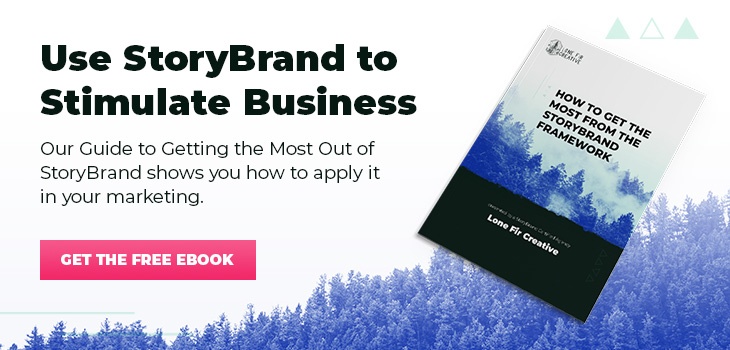Most of us can tell a good website from a bad website with just a quick glance at the homepage. In a matter of seconds, you decide if you’re interested based on a multitude of cues both in the web copy and web design. So how do you make your website engaging enough to capture people’s attention from the first moment they find your homepage?
With StoryBrand. Yep, the famous marketing framework extends even to your website design. It helps you arrange the sections of your homepage (and entire website) so that it tells a story website visitors can relate to and engage with.
Here to help us make sense of how StoryBrand fits in with website design is our Creative Team Lead and designer extraordinaire, Vanessa Wolfe. But first, let’s take a StoryBrand crash course for those who aren’t familiar with the framework or need a quick refresher.
StoryBrand Summed Up
Donald Miller invented the StoryBrand framework as a more effective approach to marketing. The philosophy behind it is that you create a story surrounding your product or service and put your buyer at the center, as the “hero.”
The approach works so well because humans are innately wired to respond to stories. We are all at the center of our own life stories, so when a brand aligns with that view, our interest is immediately piqued. From there you just follow StoryBrand’s 7 step process:
- Make your customer the hero. Put your customer right at the center of your narrative. Everything is about them, not your brand.
- Identify the problem they’re facing. Next, you need to clearly communicate the problem your customer is facing so you show that you understand their pain and empathize with their situation.
- Position yourself as the guide. Now you can position yourself as the guide to a solution (which is your product or service). Show that you know what you’re talking about and you have the solution they need.
- Outline steps to success. Once you’ve convinced them, you have to tell them exactly what they need to do to enjoy all the benefits of this solution. Outline specific steps to working with your business.
- Extend a call to action (CTA). Ask for the sale. Create a clear call to action that encourages potential customers to take the next step.
- Show them success. To give people a little extra encouragement, it’s important to show them what success looks like. Paint a picture of their hassle-free life after they decide to purchase from you.
- Show them failure. Finally, you also need to show them what life looks like if they don’t purchase from you. This might be continued feelings of frustration, overwhelm or inconvenience that could’ve been avoided with your solution.
With those key points in mind, let’s dive into why StoryBrand’s marketing strategy is such a powerful model for website design and how to implement these seven steps on your website.
Why Use StoryBrand Website Design?
“The biggest benefit of using StoryBrand website design,” Vanessa explains “is that it appeals to our emotions by using the story framework from the very first moment you enter the page. It gets us engaged and interested in what what will happen and what the outcome will be if we use the service or buy the product.”
This proven format is based on a single core principle: simplicity. As human beings, we don’t like being bombarded with information. We may even recoil.
If you don’t have a clear message, people will leave. If your design is busy and makes navigation difficult, people will leave. StoryBrand is all about capitalizing on simplicity to help people quickly understand your brand’s value.
There’s even a term StoryBrand uses to describe this — the grunt test. The grunt test uses the same criteria for your website as those old Geico commercials — so easy to understand, even a caveman can do it. Your brand message and design should be direct, clear and, above all, simple.
Elements of a StoryBrand Website
To help make the website design process simple, StoryBrand has laid out the exact elements your website needs and the order they should go in. These elements reflect the seven steps in the framework and help you draw users into a story on your homepage.
“It’s really important to arrange the sections in order when building a StoryBrand website,” Vanessa notes. “You have to follow the format of introducing the problem, establishing yourself as the guide, presenting a solution, etc. to create that logical story structure that will engage users.”
This logical story structure starts, as most stories do, with a headline.
1. The Header
Your website header is the first thing users see when they visit your homepage. It typically consists of three main elements: a headline, a header image and a CTA. Each of these elements work together to quickly communicate what you do and why people should care.
“You want to entice the user to engage with your site,” Vanessa explains. “Visually showcase what you offer and appeal to the emotions of the user with your header image and copy.”
You should always choose imagery that aligns with your brand. For example, a bake shop might include a header image of people enjoying dessert in their cafe. Or a tech company could showcase someone using their software.
Your copy should do the same. The headline is where you quickly and clearly communicate why people should learn more about your brand. Many businesses choose to use their StoryBrand one-liner as their headline, since its purpose is to do just that.
Finally, you can’t forget about the call to action button. Your CTA button should be easy to find not only in your header, but also at the top right corner of your website. It should feature a concise direction, such as “Book a Call,” “Sign Up” or “Get Started.” Make sure your button is a contrasting color to the rest of your website so it’s easy to see and click on.
2. The Stakes
The next section of your website should outline the problem people are facing and how it makes them feel. Stakes are meant to agitate their pain, which helps them realize they need a solution.
“When I design sites, I like to have the text in this section arranged in short bullet points,” Vanessa says. “I also keep the imagery pretty simple here so people can really focus on reading those stakes. You want that copy to hit home and make them think about their pain points and how much a solution would mean to them.”
There are many different ways to arrange this section, but Vanessa recommends a simple left/right design that includes a simple image or graphic and a bullet list. Your bullet list will be a quick rundown of the pain points your customer is facing and the impact those have on their lives.
3. Value Proposition
This is the section where you introduce the solution to your customers’ problem: your product.
Your value proposition is 3-5 reasons that people should purchase your product or service. It’s a few bullet points that explain how the solution works, why someone needs it and how it will improve their life.
This section is critical to convincing users they need your product. That’s why it’s wise to spend time clearly defining your value proposition within a BrandScript. The BrandScript helps you to align your values with your customers’ needs and what they want from your brand, which you should carry over to this section of your website.
“The key to the value proposition section is keeping your text really short,” Vanessa explains. “You want to create just a few concise bullet points that quickly convey powerful benefits to using your product or service. You can pair these with little icons or even animations to make your value proposition more visually interesting.”
4. Be the Guide
Now that you’ve gained your audience’s attention, established their pain points and presented a solution, it’s time to position yourself as the guide in their story. You’re the person who can take them to that solution and help them make the most of it.
“This is where you really sell them on the idea of you,” Vanessa says. “It’s where you say ‘Work with me and your life will be forever easy.’”
The key task in this section is to assert your authority as someone who can help. It’s where you can mention how many customers you’ve served, impactful data about your brand or any other information that shows you know your stuff.
“It’s helpful to use icons in this section to help visually demonstrate the information you’re conveying,” Vanessa adds. “Again, you want to keep the text simple, but the illustrations or imagery you use here can help to make this section more engaging.”
Some businesses also add testimonials or reviews below this section to offer some social proof about their brand. When potential customers see reviews from real people that you’ve helped, they’re more inclined to trust that you can do the same for them.
5. The Plan
Finally, you’ll present a plan of action users can follow to opt into your offer. This might be as simple as “Click, purchase, enjoy!” The idea is that you provide concrete, actionable steps that prepare them for the next stages in their customer journey and move them deeper into your sales funnel.
“This section is super important,” Vanessa notes. “Typically, you want to limit it to three steps. This is the easiest for people to remember and act on.”
She encourages businesses to take their time refining the language so the plan of action is incredibly clear. “So many companies make it way too confusing to figure out how to do things, and an unclear path drives frustration.”
StoryBrand adds that each step of your plan should come with a concise statement about how it benefits the user. For example, if you ask them to schedule a call, you could explain that it helps your company get aligned with their needs and suggest the best option.
These help justify why you need people to take these steps and act as an encouragement that you’ll do your due diligence to find the right solution for their situation.
Tips for Quality UX Design
Aside from these sections of your homepage, Vanessa mentions a few things you should pay attention to that affect the entirety of your website. These are common elements of quality UX design, which prioritizes user experience on your website.
The first is your main navigation. StoryBrand advises you to extend the “simplicity” mindset to this area of your website by limiting your main nav to no more than 5 links.
“These links should be exactly what the user will need to get more information about your product or service and take action on your website,” Vanessa explains.
She adds that you don’t want to collapse your navigation bar only to create large dropdown menus under each item. This can be equally overwhelming for users even if your navigation looks cleaner. Try to really prioritize only the most important items and include those in your navigation; everything else can live in your website footer.
Next, you should ensure that you’re mindful of how you design your CTAs and where you place them on your website. A few rules of thumb when it comes to CTAs include:
- Always make them a contrasting color to your website so they’re easy to see.
- There should be a CTA at the top right corner of your website and in multiple places on each web page.
- Remember to use accessibility guidelines so it’s easy for all users to read your CTA.
Finally, Vanessa urges all web designers to consider accessible web design guidelines when designing a new website or making changes to an existing one. Whether you’re wireframing and building from scratch or using a website template, there are lots of things you can do to make your website accessible to all audiences. Although these aren’t legally mandated yet, Google does reward sites that make efforts to be accessible.
Build a StoryBrand Website That Sells
Your website is your most powerful salesperson, so you want to make sure it’s working hard. The StoryBrand website design is built on the proven marketing framework and will help you not only entice and engage users, but guide them through their customer journey all the way to becoming a loyal client.
For more examples on what a StoryBrand website should look like, check out our blog.





